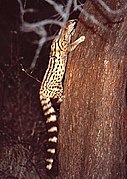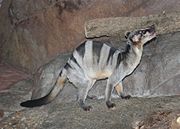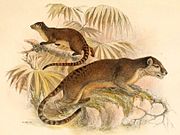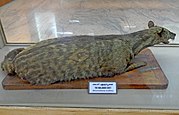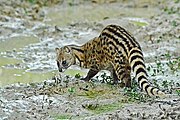Список виверридов

Viverridae - это семейство млекопитающих основном в хитрости , состоящее в из циветов и генетов . Член этой семьи называется Viverrid. Они широко распространены в основном по всей Африке, Индии и Юго -Восточной Азии и встречаются в основном в лесах, кустарниках и пастбищах, хотя некоторые виды можно найти в саваннах или водно -болотных угодьях. Большинство viverrids имеют длину от 40 до 65 см (от 16 до 26 дюймов), плюс хвост от 35 до 60 см (от 14 до 24 дюймов), хотя западноафриканский oyan может быть на 30 см (12 дюймов) плюс 35 см ( 14 дюймов) хвост, и некоторые бинтуронги могут составлять до 96 см (38 дюймов) плюс хвост 89 см (35 дюймов). Большинство видов не имеют оценки населения, хотя три виверрида классифицируются как находящиеся под угрозой исчезновения , а один- малабарский крупный цивете , классифицируется как критически подверженная исчезновению численности, размером около 200 лет. Виверрид не был одомашнен.
Тридцать три вида Viverridae разбиты на четырнадцать родов в пределах четырех подсемейств : три подсемейства Civet Viverrinae , Hemigalinae и Paradoxurinae и Genet подсемейство Genettinae . Пятая подсемейство, Prionodontinae , была ранее включена в Viverridae, в то время как виды в Genettinae считались частью Viverrinae, но более поздние генетические данные приводили к консенсусу, чтобы разделить Prionodontinae на свое семейство и разделить Genettinae на свою собственную подсемейство. Вымершие виды также были помещены в viverrinae, а также вымершие подсемейство Lophocyoninae, хотя большинство вымерших видов не были классифицированы в подсемействе. Было обнаружено почти двадцать вымерших видов Viverridae, хотя из -за продолжающихся исследований и открытий точное число и категоризация не фиксированы.
Conventions
[edit]| Conservation status | |
|---|---|
| EX | Extinct (0 species) |
| EW | Extinct in the wild (0 species) |
| CR | Critically Endangered (1 species) |
| EN | Endangered (3 species) |
| VU | Vulnerable (6 species) |
| NT | Near threatened (3 species) |
| LC | Least concern (18 species) |
| Other categories | |
| DD | Data deficient (2 species) |
| NE | Not evaluated (0 species) |
Conservation status codes listed follow the International Union for Conservation of Nature (IUCN) Red List of Threatened Species. Range maps are provided wherever possible; if a range map is not available, a description of the viverrid's range is provided. Ranges are based on the IUCN Red List for that species unless otherwise noted.
Classification
[edit]The family Viverridae consists of 33 extant species belonging to 14 genera in 4 subfamilies and divided into dozens of extant subspecies. This does not include hybrid species or extinct prehistoric species.
- Subfamily Genettinae
- Subfamily Hemigalinae
- Genus Chrotogale: one species
- Genus Cynogale: one species
- Genus Diplogale: one species
- Genus Hemigalus: one species
- Subfamily Paradoxurinae
- Genus Arctictis: one species
- Genus Arctogalidia: one species
- Genus Macrogalidia: one species
- Genus Paguma: one species
- Genus Paradoxurus: three species
- Subfamily Viverrinae
- Genus Civettictis: one species
- Genus Viverra: four species
- Genus Viverricula: one species
Viverrids
[edit]The following classification is based on the taxonomy described by Mammal Species of the World (2005), with augmentation by generally accepted proposals made since using molecular phylogenetic analysis. This includes the promotion of the Prionodontinae subfamily into its own family, and the moving of the Poiana and Genetta genera out of the Viverrinae subfamily into their own Genettinae subfamily. There are several additional proposals which are disputed, such as splitting the golden palm civet into three species or adding three additional species to Genetta, which are not included here.[1][2]
Subfamily Genettinae
[edit]| Common name | Scientific name and subspecies | Range | Size and ecology | IUCN status and estimated population |
|---|---|---|---|---|
| Abyssinian genet | G. abyssinica (Rüppell, 1836) |
Northeast Africa
|
Size: 40–43 cm (16–17 in) long, plus 38–41 cm (15–16 in) tail[3] Habitat: Forest, shrubland, and grassland[4] Diet: Primarily eats rodents, birds, and seeds, as well as insects and fruit[4][5] |
DD
|
| Angolan genet | G. angolensis Bocage, 1882 |
Scattered south-central Africa
|
Size: 44–48 cm (17–19 in) long, plus 38–43 cm (15–17 in) tail[3] Habitat: Savanna[6] Diet: Believed to primarily eat insects, as well as fruit[6][5] |
LC
|
| Aquatic genet | G. piscivora (Allen, 1919) |
Central Africa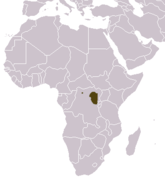
|
Size: 44–50 cm (17–20 in) long, plus 34–42 cm (13–17 in) tail[5] Habitat: Forest and inland wetlands[7] Diet: Primarily eats fish[7] |
NT
|
| Bourlon's genet
|
G. bourloni Gaubert, 2003 |
West Africa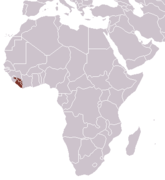
|
Size: 49–50 cm (19–20 in) long, plus 40–42 cm (16–17 in) tail[5] Habitat: Forest[8] Diet: Unknown[8][5] |
VU
|
| Cape genet | G. tigrina (Schreber, 1776) Two subspecies
|
South Africa | Size: 42–58 cm (17–23 in) long, plus 38–46 cm (15–18 in) tail[5] Habitat: Forest, shrubland, and grassland[9] Diet: Omnivorous; primarily eats insects and small mammals[9][5] |
LC
|
| Common genet | G. genetta (Linnaeus, 1758) Five subspecies
|
Bands of north, central, and south Africa and parts of Arabian peninsula (green), introduced in southwest Europe (red), formerly introduced in Nile river area (black)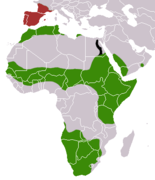
|
Size: 46–52 cm (18–20 in) long, plus 42–52 cm (17–20 in) tail[3] Habitat: Forest, savanna, shrubland, and rocky areas[10] Diet: Primarily eats small mammals, as well as birds, other small vertebrates, insects, and fruit[10] |
LC
|
| Crested servaline genet | G. cristata Hayman, 1940 |
Northwest Africa
|
Size: 49–63 cm (19–25 in) long, plus 43 cm (17 in) tail[3] Habitat: Forest[11] Diet: Primarily eats insects, as well as small mammals, reptiles, and vegetables[11][5] |
VU
|
| Giant forest genet | G. victoriae Thomas, 1902 |
Central Africa
|
Size: 55–60 cm (22–24 in) long, plus 41–49 cm (16–19 in) tail[5] Habitat: Forest[12] Diet: Primarily eats fruit, as well as rodents, birds, and insects[12][5] |
LC
|
| Hausa genet | G. thierryi Matschie, 1902 |
West Africa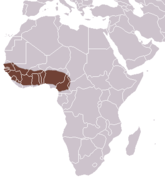
|
Size: 44–45 cm (17–18 in) long, plus 40–43 cm (16–17 in) tail[3] Habitat: Forest, savanna, and shrubland[13] Diet: Unknown[13][5] |
LC
|
| Johnston's genet
|
G. johnstoni Pocock, 1908 |
Northwest Africa
|
Size: 47–52 cm (19–20 in) long, plus 46–50 cm (18–20 in) tail[5] Habitat: Forest, savanna, and shrubland[14] Diet: Believed to primarily eat insects[14][5] |
NT
|
| King genet
|
G. poensis Waterhouse, 1838 |
Scattered parts of west Africa
|
Size: 42–68 cm (17–27 in) long, plus 35–47 cm (14–19 in) tail[5] Habitat: Forest[15] Diet: Unknown; believed to eat mammals and fruit[15] |
DD
|
| Pardine genet | G. pardina Geoffroy, 1832 |
Northwest Africa
|
Size: 41–56 cm (16–22 in) long, plus 39–45 cm (15–18 in) tail[5] Habitat: Forest, savanna, and shrubland[16] Diet: Primarily eats rodents, as well as insects, fruit, birds, and other small mammals[16][5] |
LC
|
| Rusty-spotted genet | G. maculata (Gray, 1830) |
Central and south Africa
|
Size: 41–53 cm (16–21 in) long, plus 39–54 cm (15–21 in) tail[3] Habitat: Forest, savanna, and shrubland[17] Diet: Primarily eats invertebrates, fish, amphibians, reptiles, small birds, eggs, and small mammals, as well as fruit, seeds, and berries[17][5] |
LC
|
| Servaline genet | G. servalina Pucheran, 1855 Five subspecies
|
Central africa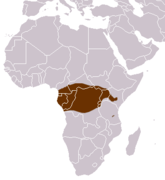
|
Size: 44–51 cm (17–20 in) long, plus 36–49 cm (14–19 in) tail[5] Habitat: Forest and shrubland[18] Diet: Primarily eats small mammals and insects, as well as snakes, birds, and fruit[18][5] |
LC
|
| Common name | Scientific name and subspecies | Range | Size and ecology | IUCN status and estimated population |
|---|---|---|---|---|
| Central African oyan | P. richardsonii (Thomson, 1842) Two subspecies
|
Central Africa
|
Size: 33–38 cm (13–15 in) long, plus 35–40 cm (14–16 in) tail[19] Habitat: Forest[20] Diet: Believed to eat small vertebrates and invertebrates[20][3] |
LC
|
| West African oyan
|
P. leightoni Pocock, 1908 |
West Africa
|
Size: 30–38 cm (12–15 in) long, plus 35–40 cm (14–16 in) tail[3] Habitat: Forest[21] Diet: Believed to eat small vertebrates and invertebrates[21][3] |
VU
|
Subfamily Hemigalinae
[edit]| Common name | Scientific name and subspecies | Range | Size and ecology | IUCN status and estimated population |
|---|---|---|---|---|
| Owston's palm civet | C. owstoni Thomas, 1912 |
Southeast Asia around Vietnam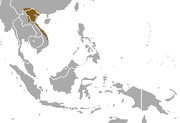
|
Size: 51–63 cm (20–25 in) long, plus 38–48 cm (15–19 in) tail[22] Habitat: Forest and shrubland[23] Diet: Believed to primarily eat earthworms and other invertebrates[23] |
EN
|
| Common name | Scientific name and subspecies | Range | Size and ecology | IUCN status and estimated population |
|---|---|---|---|---|
| Otter civet | C. bennettii (Gray, 1837) Two subspecies
|
Southeast Asia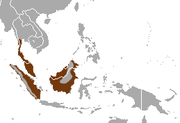
|
Size: 57–68 cm (22–27 in) long, plus 12–21 cm (5–8 in) tail[22] Habitat: Forest and inland wetlands[24] Diet: Primarily eats fish, crabs, molluscs, small mammals, and birds[24] |
EN
|
| Common name | Scientific name and subspecies | Range | Size and ecology | IUCN status and estimated population |
|---|---|---|---|---|
| Hose's palm civet | D. hosei Thomas, 1892 |
Borneo in Southeast Asia
|
Size: 47–54 cm (19–21 in) long, plus 29–34 cm (11–13 in) tail[25] Habitat: Forest[26] Diet: Believed to primarily eat small fish, shrimp, crabs, and frogs as well as insects[26] |
VU
|
| Common name | Scientific name and subspecies | Range | Size and ecology | IUCN status and estimated population |
|---|---|---|---|---|
| Banded palm civet | H. derbyanus (Gray, 1837) Four subspecies
|
Southeast Asia
|
Size: 45–56 cm (18–22 in) long, plus 25–36 cm (10–14 in) tail[22] Habitat: Forest[27] Diet: Primarily eats insects[27] |
NT
|
Subfamily Paradoxurinae
[edit]| Common name | Scientific name and subspecies | Range | Size and ecology | IUCN status and estimated population |
|---|---|---|---|---|
| Binturong | A. binturong (Raffles, 1821) Six subspecies
|
Southeast Asia
|
Size: 61–96 cm (24–38 in) long, plus 56–89 cm (22–35 in) tail[28] Habitat: Forest[29] Diet: Primarily eats fruit[29] |
VU
|
| Common name | Scientific name and subspecies | Range | Size and ecology | IUCN status and estimated population |
|---|---|---|---|---|
| Small-toothed palm civet | A. trivirgata (Gray, 1832) Fourteen subspecies |
Southeast Asia
|
Size: 44–60 cm (17–24 in) long, plus 48–66 cm (19–26 in) tail[30] Habitat: Forest[31] Diet: Omnivorous; primarily eats fruit[31] |
LC
|
| Common name | Scientific name and subspecies | Range | Size and ecology | IUCN status and estimated population |
|---|---|---|---|---|
| Sulawesi palm civet | M. musschenbroekii (Schlegel, 1877) |
Sulawesi island in Southeast Asia
|
Size: 65–72 cm (26–28 in) long, plus 44–54 cm (17–21 in) tail[3] Habitat: Forest, shrubland, and grassland[32] Diet: Primarily eats rodents and palm fruit, as well as other small mammals, birds, fruit, and grass[32] |
VU
|
| Common name | Scientific name and subspecies | Range | Size and ecology | IUCN status and estimated population |
|---|---|---|---|---|
| Masked palm civet | P. larvata (H. Smith, 1827) Sixteen subspecies |
East and southeast Asia
|
Size: 50–76 cm (20–30 in) long, plus 50–64 cm (20–25 in) tail[33] Habitat: Forest and shrubland[34] Diet: Omnivorous; primarily eats fruit[34] |
LC
|
| Common name | Scientific name and subspecies | Range | Size and ecology | IUCN status and estimated population |
|---|---|---|---|---|
| Asian palm civet | P. hermaphroditus (Pallas, 1777) 30 subspecies |
South and southeast Asia (green), introduced (red)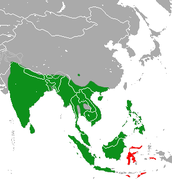
|
Size: 47–57 cm (19–22 in) long, plus 47–56 cm (19–22 in) tail[35] Habitat: Forest, shrubland, and grassland[36] Diet: Primarily eats rats and fruit, as well as insects and molluscs[36] |
LC
|
| Brown palm civet | P. jerdoni Blanford, 1885 Two subspecies
|
Southwest India
|
Size: 43–62 cm (17–24 in) long, plus 38–53 cm (15–21 in) tail[37] Habitat: Forest[38] Diet: Primarily eats fruit, as well as birds, rodents, and insects[38] |
LC
|
| Golden palm civet | P. zeylonensis (Schreber, 1778) |
Sri Lanka
|
Size: 50–58 cm (20–23 in) long, plus 43–53 cm (17–21 in) tail[3] Habitat: Forest and shrubland[39] Diet: Primarily eats berries, fruits, and invertebrates, as well as small vertebrates[39] |
LC
|
Subfamily Viverrinae
[edit]| Common name | Scientific name and subspecies | Range | Size and ecology | IUCN status and estimated population |
|---|---|---|---|---|
| African civet | C. civetta (Schreber, 1776) Six subspecies
|
Central and south Africa
|
Size: 60–92 cm (24–36 in) long, plus 43–61 cm (17–24 in) tail[40] Habitat: Forest, savanna, shrubland, and inland wetlands[41] Diet: Omnivorous; primarily eats fruit[41] |
LC
|
| Common name | Scientific name and subspecies | Range | Size and ecology | IUCN status and estimated population |
|---|---|---|---|---|
| Large-spotted civet | V. megaspila Blyth, 1862 |
Southeast Asia
|
Size: 77–90 cm (30–35 in) long, plus 32–40 cm (13–16 in) tail[35] Habitat: Forest, shrubland, and inland wetlands[42] Diet: Primarily eats birds, frogs, snakes, small mammals, eggs, crabs, fish, fruit, and roots[35][42] |
EN
|
| Large Indian civet | V. zibetha Linnaeus, 1758 Five subspecies
|
Southeast Asia
|
Size: 50–95 cm (20–37 in) long, plus 38–59 cm (15–23 in) tail[35] Habitat: Forest and shrubland[43] Diet: Primarily eats fish, birds, lizards, frogs, insects, arthropods, and crabs, as well as poultry and rubbish[43] |
LC
|
| Malabar large-spotted civet | V. civettina Blyth, 1862 |
Southwest India
|
Size: 76 cm (30 in) long, plus 33 cm (13 in) tail[44] Habitat: Forest and inland wetlands[45] Diet: Unknown[45] |
CR
|
| Malayan civet | V. tangalunga Gray, 1832 Two subspecies
|
Southeast Asia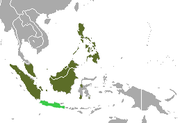
|
Size: 58–95 cm (23–37 in) long, plus 30–49 cm (12–19 in) tail[46] Habitat: Forest and shrubland[47] Diet: Omnivorous[47] |
LC
|
| Common name | Scientific name and subspecies | Range | Size and ecology | IUCN status and estimated population |
|---|---|---|---|---|
| Small Indian civet | V. indica (Desmarest, 1804) Twelve subspecies |
South and southeast Asia
|
Size: 45–63 cm (18–25 in) long, plus 30–43 cm (12–17 in) tail[48] Habitat: Forest, savanna, shrubland, grassland, and inland wetlands[49] Diet: Primarily eats rodents, birds, snakes, fruit, roots, carrion, and insects[49] |
LC
|
References
[edit]- ^ Groves, C. P.; Rajapaksha, C.; Manemandra-Arachchi, K. (2009). "The taxonomy of the endemic golden palm civet of Sri Lanka" (PDF). Zoological Journal of the Linnean Society. 155: 238–251. doi:10.1111/j.1096-3642.2008.00451.x.
- ^ Gaubert, P.; Taylor, P. J.; Veron, G. (2005). "Integrative taxonomy and phylogenetic systematics of the genets (Carnivora, Viverridae, Genetta): a new classification of the most speciose carnivoran genus in Africa" (PDF). In Huber, B. A.; Sinclair, B. J.; Lampe, K. H. (eds.). African Biodiversity: Molecules, Organisms, Ecosystems. Proceedings of the 5th International Symposium of Tropical Biology, Museum König, Bonn. Springer Science+Business Media. pp. 371–383.
- ^ Jump up to: a b c d e f g h i j k Hunter, Luke; Barrett, Priscilla (2020). Field Guide to Carnivores of the World (2nd ed.). Bloomsbury Publishing. pp. 82, 90–96. ISBN 978-1-4729-8267-4.
- ^ Jump up to: a b c Gaubert, P.; Duckworth, J. W.; Do Linh San, E. (2016). "Genetta abyssinica". IUCN Red List of Threatened Species. 2016: e.T8994A45198149. doi:10.2305/IUCN.UK.2016-1.RLTS.T8994A45198149.en.
- ^ Jump up to: a b c d e f g h i j k l m n o p q r s Van Rompaey, H.; Colyn, M. (2014). Kingdon, J.; Hoffmann, M. (eds.). The Mammals of Africa. Vol. V. Carnivores, Pangolins, Equids and Rhinoceroses. Bloomsbury Publishing. pp. 218–248. ISBN 978-1-4081-8994-8.
- ^ Jump up to: a b c Gaubert, P.; Fischer, C.; Hausser, Y.; Do Linh San, E. (2016). "Genetta angolensis". IUCN Red List of Threatened Species. 2016: e.T41696A45218468. doi:10.2305/IUCN.UK.2016-1.RLTS.T41696A45218468.en.
- ^ Jump up to: a b c Gaubert, P.; Do Linh San, E. (2015). "Genetta piscivora". IUCN Red List of Threatened Species. 2015: e.T15628A45201673. doi:10.2305/IUCN.UK.2015-4.RLTS.T15628A45201673.en.
- ^ Jump up to: a b c Gaubert, P.; Greengrass, E. J.; Do Linh San, E. (2015). "Genetta bourloni". IUCN Red List of Threatened Species. 2015: e.T136223A45220931. doi:10.2305/IUCN.UK.2015-4.RLTS.T136223A45220931.en.
- ^ Jump up to: a b c Gaubert, P.; Do Linh San, E. (2015). "Genetta tigrina". IUCN Red List of Threatened Species. 2015: e.T41702A45219459. doi:10.2305/IUCN.UK.2015-4.RLTS.T41702A45219459.en.
- ^ Jump up to: a b c Gaubert, P.; Carvalho, F.; Camps, D.; Do Linh San, E. (2015). "Genetta genetta". IUCN Red List of Threatened Species. 2015: e.T41698A45218636. doi:10.2305/IUCN.UK.2015-4.RLTS.T41698A45218636.en.
- ^ Jump up to: a b c Gaubert, P.; Angelici, F. M.; Do Linh San, E. (2015). "Genetta cristata". IUCN Red List of Threatened Species. 2015: e.T8998A45198406. doi:10.2305/IUCN.UK.2015-4.RLTS.T8998A45198406.en.
- ^ Jump up to: a b c Gaubert, P.; Dinets, V.; Do Linh San, E. (2016). "Genetta victoriae". IUCN Red List of Threatened Species. 2016: e.T41703A45219531. doi:10.2305/IUCN.UK.2016-1.RLTS.T41703A45219531.en.
- ^ Jump up to: a b c Gaubert, P.; Do Linh San, E. (2015). "Genetta thierryi". IUCN Red List of Threatened Species. 2015: e.T41701A45219325. doi:10.2305/IUCN.UK.2015-4.RLTS.T41701A45219325.en.
- ^ Jump up to: a b c Gaubert, P.; Do Linh San, E. (2016). "Genetta johnstoni". IUCN Red List of Threatened Species. 2016: e.T8997A45198265. doi:10.2305/IUCN.UK.2016-1.RLTS.T8997A45198265.en.
- ^ Jump up to: a b c Gaubert, P.; Do Linh San, E. (2015). "Genetta poensis". IUCN Red List of Threatened Species. 2015: e.T136435A45221269. doi:10.2305/IUCN.UK.2015-4.RLTS.T136435A45221269.en.
- ^ Jump up to: a b c Gaubert, P.; Do Linh San, E. (2016). "Genetta pardina". IUCN Red List of Threatened Species. 2016: e.T136437A45221360. doi:10.2305/IUCN.UK.2016-1.RLTS.T136437A45221360.en.
- ^ Jump up to: a b c Angelici, F. M.; Gaubert, P.; Do Linh San, E. (2016). "Genetta maculata". IUCN Red List of Threatened Species. 2016: e.T41699A45218948. doi:10.2305/IUCN.UK.2016-1.RLTS.T41699A45218948.en.
- ^ Jump up to: a b c Gaubert, P.; De Luca, D. W.; Rovero, F.; Do Linh San, E. (2016). "Genetta servalina". IUCN Red List of Threatened Species. 2016: e.T41700A97163789. doi:10.2305/IUCN.UK.2016-1.RLTS.T41700A97163789.en.
- ^ Gillette, Corinna (2005). "Poiana richardsonii". Animal Diversity Web. University of Michigan. Retrieved April 16, 2020.
- ^ Jump up to: a b c Gaubert, P.; Do Linh San, E. (2015). "Poiana richardsonii". IUCN Red List of Threatened Species. 2015: e.T41704A45219609. doi:10.2305/IUCN.UK.2015-4.RLTS.T41704A45219609.en.
- ^ Jump up to: a b c Gaubert, P.; Do Linh San, E. (2015). "Poiana leightoni". IUCN Red List of Threatened Species. 2015: e.T44165A45220840. doi:10.2305/IUCN.UK.2015-4.RLTS.T44165A45220840.en.
- ^ Jump up to: a b c Francis, Charles (2019). Field Guide to the Mammals of South-east Asia (2nd ed.). Bloomsbury Publishing. pp. 313–316. ISBN 978-1-4729-3499-4.
- ^ Jump up to: a b c Timmins, R. J.; Coudrat, C. N. Z.; Duckworth, J. W.; Gray, T. N. E.; Robichaud, W.; Willcox, D. H. A.; Long, B.; Roberton, S. (2016). "Chrotogale owstoni". IUCN Red List of Threatened Species. 2016: e.T4806A45196929. doi:10.2305/IUCN.UK.2016-1.RLTS.T4806A45196929.en.
- ^ Jump up to: a b c Ross, J.; Wilting, A.; Ngoprasert, D.; Loken, B.; Hedges, L.; Duckworth, J. W.; Cheyne, S.; Brodie, J.; Chutipong, W.; Hearn, A.; Linkie, M.; McCarthy, J.; Tantipisanuh, N.; Haidir, I. A. (2015). "Cynogale bennettii". IUCN Red List of Threatened Species. 2015: e.T6082A45197343. doi:10.2305/IUCN.UK.2015-4.RLTS.T6082A45197343.en.
- ^ Van Rompaey, H.; Azlan, M. J. (2004). "Hose's Civet, Diplogale hosei" (PDF). Small Carnivore Conservation. 30: 18–19. Archived from the original (PDF) on April 26, 2012.
- ^ Jump up to: a b c Mathai, J.; Duckworth, J. W.; Wilting, A.; Hearn, A.; Brodie, J. (2015). "Diplogale hosei". IUCN Red List of Threatened Species. 2015: e.T6635A45197564. doi:10.2305/IUCN.UK.2015-4.RLTS.T6635A45197564.en.
- ^ Jump up to: a b c Ross, J.; Brodie, J.; Cheyne, S.; Chutipong, W.; Hedges, L.; Hearn, A.; Linkie, M.; Loken, B.; Mathai, J.; McCarthy, J.; Ngoprasert, D.; Tantipisanuh, N.; Wilting, A.; Haidir, I. A. (2015). "Hemigalus derbyanus". IUCN Red List of Threatened Species. 2015: e.T41689A45216918. doi:10.2305/IUCN.UK.2015-4.RLTS.T41689A45216918.en.
- ^ Schleif, Molly (2013). "Arctictis binturong". Animal Diversity Web. University of Michigan. Retrieved April 16, 2020.
- ^ Jump up to: a b c Willcox, D. H. A.; Chutipong, W.; Gray, T. N. E.; Cheyne, S.; Semiadi, G.; Rahman, H.; Coudrat, C. N. Z.; Jennings, A.; Ghimirey, Y.; Ross, J.; Fredriksson, G.; Tilker, A. (2016). "Arctictis binturong". IUCN Red List of Threatened Species. 2016: e.T41690A45217088. doi:10.2305/IUCN.UK.2016-1.RLTS.T41690A45217088.en.
- ^ Bauer, Chris (2013). "Arctogalidia trivirgata". Animal Diversity Web. University of Michigan. Retrieved April 16, 2020.
- ^ Jump up to: a b c Willcox, D. H. A.; Duckworth, J. W.; Timmins, R. J.; Chutipong, W.; Choudhury, A.; Roberton, S.; Long, B.; Hearn, A.; Ross, J. (2016). "Arctogalidia trivirgata". IUCN Red List of Threatened Species. 2016: e.T41691A45217378. doi:10.2305/IUCN.UK.2016-1.RLTS.T41691A45217378.en.
- ^ Jump up to: a b c Tasirin, J.; Dinets, V.; Meijaard, E.; Brodie, J.; Nijman, V.; Loffeld, T. A. C.; Hilser, H.; Shepherd, C.; Seymour, A. S.; Duckworth, J. W. (2015). "Macrogalidia musschenbroekii". IUCN Red List of Threatened Species. 2015: e.T12592A45198901. doi:10.2305/IUCN.UK.2015-4.RLTS.T12592A45198901.en.
- ^ Lundrigan, Barbara; Baker, Steve (2003). "Paguma larvata". Animal Diversity Web. University of Michigan. Retrieved April 16, 2020.
- ^ Jump up to: a b c Duckworth, J. W.; Timmins, R. J.; Chutipong, W.; Choudhury, A.; Mathai, J.; Willcox, D. H. A.; Ghimirey, Y.; Chan, B.; Ross, J. (2016). "Paguma larvata". IUCN Red List of Threatened Species. 2016: e.T41692A45217601. doi:10.2305/IUCN.UK.2016-1.RLTS.T41692A45217601.en.
- ^ Jump up to: a b c d Smith, Andrew T.; Xie, Yan; Hoffmann, Robert S.; Lunde, Darrin; MacKinnon, John; Wilson, Don E.; Wozencraft, W. Chris, eds. (2010). A Guide to the Mammals of China. Princeton University Press. pp. 412–413. ISBN 978-1-4008-3411-2.
- ^ Jump up to: a b c Duckworth, J. W.; Timmins, R. J.; Choudhury, A.; Chutipong, W.; Willcox, D. H. A.; Mudappa, D.; Rahman, H.; Widmann, P.; Wilting, A.; Xu, W. (2016). "Paradoxurus hermaphroditus". IUCN Red List of Threatened Species. 2016: e.T41693A45217835. doi:10.2305/IUCN.UK.2016-1.RLTS.T41693A45217835.en.
- ^ Bodle, Jessica (2013). "Paradoxurus jerdoni". Animal Diversity Web. University of Michigan. Retrieved April 16, 2020.
- ^ Jump up to: a b c Mudappa, D.; Choudhury, A.; Punjabi, G. A. (2016). "Paradoxurus jerdoni". IUCN Red List of Threatened Species. 2016: e.T16104A45201757. doi:10.2305/IUCN.UK.2016-1.RLTS.T16104A45201757.en.
- ^ Jump up to: a b c Duckworth, J. W.; Mudappa, D.; Pethiyagoda, R.; Woolgar, J.; de Silva Wijeyeratne, G.; Hall, J. (2016). "Paradoxurus zeylonensis". IUCN Red List of Threatened Species. 2016: e.T41694A45218119. doi:10.2305/IUCN.UK.2016-1.RLTS.T41694A45218119.en.
- ^ Shalu, Tuteja (2000). "Civettictis civetta". Animal Diversity Web. University of Michigan. Retrieved April 16, 2020.
- ^ Jump up to: a b c Do Linh San, E.; Gaubert, P.; Wondmagegne, D.; Ray, J. (2019) [amended version of 2015 assessment]. "Civettictis civetta". IUCN Red List of Threatened Species. 2019: e.T41695A147992107. doi:10.2305/IUCN.UK.2019-2.RLTS.T41695A147992107.en.
- ^ Jump up to: a b c Timmins, R.; Duckworth, J. W.; WWF-Malaysia, Roberton; S., Gray; T. N. E., Willcox; D. H. A., Chutipong; W., Long; B. (2016). "Viverra megaspila". IUCN Red List of Threatened Species. 2016: e.T41707A45220097. doi:10.2305/IUCN.UK.2016-1.RLTS.T41707A45220097.en.
- ^ Jump up to: a b c Тимминс, RJ; Duckworth, JW; Chutipong, W.; Ghimirey, Y.; Willcox, DHA; Rahman, H.; Long, B.; Choudhury, A. (2016). " Виверра Зибита Красный Список угрожаемых видов МСКн 2016 : E.T41709A4522 Doi : 10.2305/iucn.2016-1.rlts.t41709a45220429 .
- ^ Менон, Вивек (2014). "Малабарская цивета". Индийские млекопитающие: полевой гид . Хахетт Индия . ISBN 978-93-5009-760-1 .
- ^ Jump up to: а беременный в Mudappa, D.; Helgen, K.; Нандини Р. (2016). " Viverra Civettina " . МСОП красный список угрожаемых видов . 2016 : E.T23036A45202281. doi : 10.2305/iucn.uk.2016-1.rlts.t23036a45202281.en .
- ^ Лундриган, Барбара; Харрис, Джули (2000). " Viverra Tangalung -разнообразие животных Интернет университет Мичиганский Получено 16 , апреля
- ^ Jump up to: а беременный в Duckworth, JW; Mathai, J.; Увядание, а.; Холден, Дж.; Хирн, А.; Росс, Дж. (2016). " Viverra Tangalunga " . МСОП красный список угрожаемых видов . 2016 : E.T41708A45220284. doi : 10.2305/iucn.uk.2016-1.rlts.t41708a45220284.en .
- ^ Уокер, Эрнест Пилсбери; Новак, Рональд М. (1999). Уокерские млекопитающие мира . Тол. 1. Johns Hopkins University Press . п. 751. ISBN 978-0-8018-5789-8 .
- ^ Jump up to: а беременный в Choudhury, A.; Duckworth, JW; Timmins, R.; Chutipong, W.; Willcox, DHA; Rahman, H.; Ghimirey, Y.; Mudappa, D. (2015). " Viverricula indica " . МСОП красный список угрожаемых видов . 2015 : E.T41710A45220632. doi : 10.2305/iucn.uk.2015-4.rlts.t41710a45220632.en .

